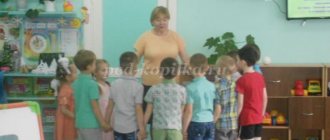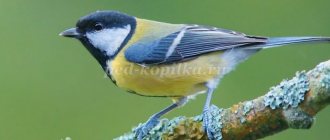Summary of GCD for drawing in the middle group on the topic “Decorating a Sweater”
Nadezhda Ogarkova
Notes on drawing in the middle group on the topic “Decorating a Sweater”
Summary of GCD for drawing in the middle group on the topic : “ Decorating a sweater ”
Program content: Strengthen children's ability to decorate items of clothing using lines, strokes, dots, circles and other familiar elements. Decorate clothes cut out of paper with decorated stripes. Learn to select colors according to the color of the sweater . Develop aesthetic perception, independence, initiative.
Sweaters of different colors cut out of thick paper , gouache, tassels, tassel stands, oilcloths, sippy cups, napkins.
Topics “Decorating a Sweater”: options and wording
This lesson topic is related to the study and decoration of clothes and is offered to children after they have completed simpler tasks that gradually become more complex, for example:
- scarf (stripe);
- handkerchief (triangle);
- napkin (square);
- apron (square or oval);
- hat and mittens.
T.S. Komarova, in her work “Visual activities in kindergarten: middle group,” suggests holding classes in November and emphasizing the need for warm clothing according to the season to maintain health.
Table: possible lesson topics and their content
| “Sweater for my friends” (drawing using non-traditional finger technique) | Objectives: introduce finger painting techniques; develop initiative, consolidate knowledge of colors; learn to make a basic pattern. Equipment: two dolls - a boy and a girl, gouache, silhouettes of sweaters of different colors, sketches of sweaters with different patterns. |
| “Lacy Sweater” (painting in gouache using cotton swabs) | Objectives: learn to apply a pattern to a sweater template using a simple pencil and ruler; Using a cotton swab and white gouache, outline your openwork patterns. |
| “Sweater in the style of Dymkovo ornament” (drawing in traditional techniques using brushes and paints) | Objectives: to consolidate the ability to decorate the silhouette of a sweater using Dymkovo painting; teach the selection of colors in accordance with the color of the sweater; cultivate aesthetic taste and perception. Materials: cut out silhouettes of sweaters of different colors, paints, brush, water jar, napkin, music, table with elements of floral patterns. |
| “Sweater for a bunny” (drawing using traditional techniques using brushes and paints) | Objectives: to strengthen children’s ability to decorate items of clothing using lines, strokes, dots, circles and other familiar elements; decorate clothes cut out of paper with stripes; teach the selection of colors in accordance with the color of the sweater; develop aesthetic perception, independence, initiative. Equipment for the teacher: pictures of sweaters with different patterns, toys: a wet hare, a dry hare, a sweater knitted onto a toy, a magnetic board. Equipment for children: sweaters cut out of thick paper, brushes, paints, jars of water, napkins. |
| “Decorating sweaters for boys and girls” (drawing using traditional techniques using brushes and paints) | Objectives: to reinforce the idea of winter clothing and the importance of warm clothing for maintaining health; teach awareness of gender differences among peers; consolidate the ability to create a pattern on a strip using lines, strokes, dots, circles and other familiar elements; learn to choose color combinations. Demonstration equipment: boy's sweater, girl's sweater. Handout: sweater templates, paints, brushes, brush holders, napkins. |
| “Sweater for a doll” (painting in gouache using cotton swabs) | Objectives: to strengthen children’s ability to decorate items of clothing using lines, strokes, dots, circles and other familiar elements; decorate clothes cut out of paper with stripes; learn to select colors according to the color of the sweater; develop aesthetic perception, independence and initiative. Materials: paper dolls, sweaters cut out of thick paper in different colors, paints, gouache, brushes, cotton swabs, glasses of water, presentation on the topic: “Clothing.” |
Photo gallery: children's work on a sweater stencil for drawing in the middle group, painted with gouache using cotton swabs - “Lacy Sweater”
Yellow and white create a feeling of warmth
Green is one of children's favorite colors
Red and white - a classic holiday combination
Contrasting combinations look beautiful
Summary of the drawing lesson “Decorating a Sweater”
Olga Pozhalueva
Summary of the drawing lesson “Decorating a Sweater”
“
Decorating a Sweater ” (middle group)
- Continue teaching children to draw with their fingers .
-To strengthen children’s ability to decorate items of clothing using strokes, dots, circles and other familiar elements.
— Develop aesthetic perception, independence, initiative.
Materials for the lesson . Sweaters cut out of thick paper , toys: hare, gouache, wet wipes.
A motivating start to the lesson on the topic “Decorating a Sweater.”
Drawing an ornament in itself may not be interesting to middle-aged preschoolers. To activate attention and encourage creative activity, first of all, it is recommended to attract the children’s personal perception of visual images and use game elements in the lesson.
Motivating material at the initial stage of the lesson.
| Material option | Use as a motivating start to a lesson |
| Visual material | The guys study pictures with sweaters. The teacher conducts a conversation : What elements are the patterns made of? What techniques can you use to make similar patterns on paper (rhythmic repetition, alternation). What color combinations are presented in these sweater models? An option for visual material could be sweaters worn by the students themselves. The task of bringing your favorite sweater on the appointed day brings particular excitement. Immediately at the beginning of the lesson, the teacher suggests organizing a fashion show: the teacher turns on cheerful music, the children put on the sweaters they brought and take turns parading, demonstrating the pattern on the product. Next, a conversation is held on the features of the sweaters seen. |
| Game situation | The teacher draws the children's attention to the fact that winter is approaching, the frosty season is beginning, and the toys/dolls in their group do not have warm clothes. The children are invited to choose a toy and prepare beautiful sweaters for them as a gift. On the table in front of each student is a drawing of a girl or boy and a paper sweater. Children are invited to draw a pattern on the blank and “put” the sweater on the child from the picture so that he does not freeze while walking. If the group has paper dolls with a paper “wardrobe”, then for the lesson you can make blanks with “ears” so that the children can use the decorated sweaters in the subsequent game. |
| Surprise moments | Fox (a junior teacher or another employee in a fox costume) enters the group, greets the children and complains about the cold. The fox asks the guys to tell her what to do so that the fox cubs do not freeze while walking. When the children say that they can put warm clothes on the foxes, the little fox cries that she doesn’t know how to sew or knit. The teacher guides the children through leading questions or hints that they can draw and decorate sweaters for the foxes. There is a box on the teacher's desk. The teacher reports that the postman delivered her to the group in the morning and reads out the address (the real address of the kindergarten: city, street, house, group number). When asked what to do with the box, the children, of course, offer to open it, which the teacher does. The box contains paper blanks of sweaters of the same color and a letter from the Gnome. The teacher reads out the letter: The gnome says that in the fall his grandmother knitted sweaters for him and his many brothers, but they are all the same size and color - the gnomes confuse which sweater belongs to whom, and ask the children for help. The teacher offers to disassemble the blanks and decorate them at their own request, so that each gnome has his own unique sweater. |
| Didactic games | Collective didactic games are held with children aged 4–5 years: tasks are not given on cards, but are presented on large pictures/posters or projected on the screen. Game options: “Find the differences.” You need to find the differences in two identical pictures of sweaters; the teacher immediately names their number. “Find a sweater by silhouette.” The picture shows sweaters and one shadow silhouette. “Find identical pairs.” Among the sweaters shown in the picture you need to find the same ones. “Which sweater suits who?” On the left side of the picture there are sweaters with different patterns, on the right there are characters. For example, a sweater with bows is suitable for a girl, a sweater with cars is suitable for a boy, and a sweater with carrots will please a bunny. |
Drawing up notes on the topic “Decorating a Sweater.”
Purpose of the lesson: decorating a paper blank with a decorative pattern.
Objectives: strengthening the ability to draw lines, strokes/shading, dots, circles and rings, checkmarks with a brush and/or pencil; developing the ability to decorate finished work with elements of other types of visual arts (paper strips or figures, plasticine parts); development of a sense of color; development of the ability to see beauty in objects of the surrounding reality; activation of fantasy; fostering independence and initiative.
In accordance with hygiene standards, the duration of a drawing lesson in the middle group is no more than 20 minutes and consists of the following stages:
- Organizational moment 1 minute.
- Motivating start of the lesson 4-5 minutes.
- Practical work 10 minutes.
- Demonstration and discussion of finished works for 2–3 minutes.
- Summing up the lesson 1 minute.
The teacher needs to draw up a detailed plan for each lesson, followed by a mandatory analysis: whether the set goals and objectives were achieved, whether the teaching methods and techniques used were effective, how the children behaved at various stages of the lesson, difficulties and delays at any stages of the lesson and their reasons, analysis of students’ work, approximate ways to improve the conduct of classes.
Methodological development for drawing (middle group) on the topic “Decorative drawing “Decoration of a sweater”.” Author: Selezneva Natalya Ivanovna.
| Goals and objectives | Consolidating the ability to decorate a piece of clothing using familiar elements: lines, strokes, dots, rings and circles. Decorating the workpiece with paper strips. Development of aesthetic perception and independence. |
| Materials | Sweater blanks made of thick paper in different colors, paper strips for decorating the neckline, cuffs and elastic. |
| Connection with other aspects of educational work | Study of decorative patterns on garments. |
| Progress of the lesson | Creating a problematic situation. The teacher brings a stuffed hare to the group and reads A. Barto’s poem “The Mistress Abandoned the Bunny.” The guys are informed that the bunny himself got wet in the rain, and, of course, his sweater got wet - it became colorless and the design was washed off. How can you help a bunny? The guys offer to re-draw the pattern on the bunny’s sweater. Communicating the purpose of the lesson, identifying the task for practical work. Carrying out physical education under the lines of a poem about flowers. Before the children begin the task, the teacher draws attention to the fact that there is not enough orange paint on their tables; the children remember what colors need to be mixed to get orange. Pedagogical demonstration. The teacher invites the children to remember the elements for decorative drawing and demonstrates their implementation on the board/easel. During practical work, the teacher monitors the process of children mixing paints on the palette, the correctness of drawing with a brush, filling the entire area of the workpiece, and the students’ posture. The children attach the decorated sweaters to a magnetic board. Discussion of works. Summing up the lesson. Bunny says that the guys made bright and beautiful sweaters with interesting patterns, and thanks them for their effort and imagination. |
Progress of the lesson:
Creating a problem situation:
The teacher brings Bunny into the group, who cries loudly.
The owner abandoned the bunny -
Bunny was left in the rain,
I couldn't get off the bench,
I was completely wet. (A. Barto)
Educator: Guys, what happened to Bunny (got wet in the rain)
.
Educator: The bunny got wet, his sweater became wet , the colors turned pale, the drawing on it was gone. How can you help Bunny? ( draw a pattern )
.Today we will
decorate a sweater with lines , dots, circles and other familiar elements; for this we will need paints of different colors.
Didactic exercise “Be attentive”
:
Red color - clap your hands
Blue color - hands up
Educator: You see, Bunny, how many bright colors we have. Guys, are you ready to help the bunny? Yes.
- Look, Bunny gave each of you a sweater , let's decorate them with paints . And so that our patterns turn out beautiful, we first warm up our fingers.
Once upon a time there was a bunny - (clap hands)
Long ears (three fingers in a fist, index and middle - ears)
.
The bunny is frozen (clench and unclench the fingers of both hands)
Nose on the edge (rubbing the nose)
.
Frostbitten nose (clench and unclench the fingers of both hands,
My tail is frozen (they wave their hand to imitate a tail)
.
And went to warm up (turn the steering wheel)
Visit the kids.
It’s warm and quiet there (they unclench the fists of both hands,
There is no wolf (clap hands,
Summary of a lesson on unconventional drawing “Mittens” in the middle group of kindergarten
Summary of GCD in the middle group in a non-traditional drawing technique - monotype on the topic: “Mittens”
Goal: to continue to acquaint students with the technique of non-traditional drawing - monotype with the aim of developing creative abilities in the process of visual activity. Objectives: • To develop the ability to draw in an unconventional way: with an imprint on a sheet. • Develop visual skills; • Fix the names of the primary colors: red, blue, yellow, green; • Cultivate aesthetic taste by giving the opportunity to choose a color. • Develop the ability to establish contact and communicate freely; • Develop and activate vocabulary: clothes, hat, jacket, pants, scarf, mittens, sweater, fur coat, boots, felt boots; • Develop the ability to answer the teacher’s question. Expected result: formation of students' interest in unconventional drawing; Preliminary work: • Conversations with students about clothing. • Game educational situation “Travel with the doll Katya.” • Game educational situation “We now know how to dress ourselves for a walk” • Didactic games: “Find your locker”, “Let’s choose clothes for the dolls”, “Let’s dress the doll for a walk”, “Let’s teach the doll Katya to undress”, “Let’s put the doll Katya to sleep” • Folk songs, nursery rhymes: “Potyagunushki”; “Our Masha is small...”; “Felt boots, felt boots, small ones, small ones...” • Examination of illustrations depicting clothes; looking at winter outerwear while walking, asking riddles about clothes. Equipment: A4 sheets for each child, gouache, pencil, wet wipes;
gouache of different colors; a sample of a painted mitten; didactic games “Dress the doll correctly”, “Find a pair”; paper doll Masha in winter clothes without mittens. GCD
progress Educator: - Guys, look, Masha is getting ready to go for a walk. Tell me, did Masha dress correctly for the walk? (Children's answers) What time is it outside the window now? What didn’t Masha wear outside in winter? Guys, can we help Masha get dressed? What should you wear first? Didactic game “Choose the right clothes.” Didactic game “Help me find the Mitten Machine among all the things.”
- Guys, since you and I helped Masha pick out winter clothes for a walk and even found her mittens.
Let's dress her now and then show her what kind of finger gymnastics we can do. And she will sit and listen. Finger gymnastics “We went for a walk in the yard” We went for a walk in the yard. ( “Walk” along the legs with the index middle fingers
).
They sculpted a snow woman ( they “sculpt” a lump with two palms
).
The birds were fed crumbs ( “Crumbing the bread” with all their fingers
).
Then we rode down the hill, ( Run the index finger of the right hand along the palm of the left hand
).
And they were also lying in the snow. ( Put their palms on the table, first one side, then the other
).
Everyone came home covered in snow. ( Dust off palms
).
We ate soup and went to bed. ( Movements with an imaginary spoon; hands under the cheek
).
Educator: Guys, now I suggest you draw the mittens yourself, but in an unusual way. The method we use when drawing is called monotype. We will draw one mitten, and then apply this method and we will have a second mitten, which we will not draw. You will find out everything yourself, see, try to do it and then you will understand what monotype is. Guys, first of all, look at how I will do this work now. Look carefully. Now I will put my palm on the sheet and outline it with a pencil. And after that I’ll paint over it and cover it with the other half of the sheet. And this is what I got. Guys, you just watched me draw a pair of mittens. So who can tell from that. what did you see, what is monotype? (children's answers). Right! Now try it. You can even draw different patterns on them if you want. But first, let's remember that you need to be careful while drawing and remember the sequence of actions. Independent activity of children Teacher: what beautiful mittens you made! While the mittens are drying, you and I will play! Didactic game “Find a Pair” There are mittens on the table, as soon as the music starts, you quickly take one of the mittens and look for a pair. Whoever finds a pair faster is the winner! Educator: Look at the mittens you drew. (children's names)
what color is your mitten? Yes, right. We made so many wonderful mittens! Now you will all be warm! If you have a desire, then you can give them to the doll Masha, and she will be very happy and will take them to her friends and give them as gifts.
We recommend watching:
Summary of educational activities for children of the middle group on the topic: Winter Physical education entertainment “Winter-winter” for children of the middle group of preschool educational institutions Summary of educational activities in the middle group on the topic: Winter Summary of organized educational activities with children of the middle group on the topic: Winter
Similar articles:
Observation “Footprints in the snow.” Middle group
Walk observation in winter in the middle group. Winter clothes
Summary of a drawing lesson in the junior group “Decorating a Sweater”
Olga Volchenkova
Summary of a drawing lesson in the junior group “Decorating a Sweater”
Summary of a drawing lesson in the junior group “Decorating a Sweater”
Tasks:
Educational:
Strengthen children's ability to decorate items of clothing using lines, strokes, circles and other familiar elements.
Educational:
Develop aesthetic perception, independence and initiative.







